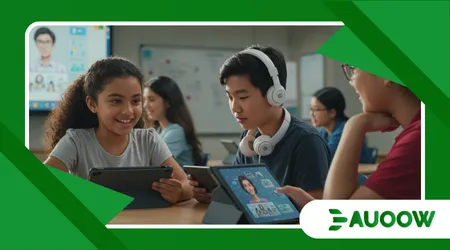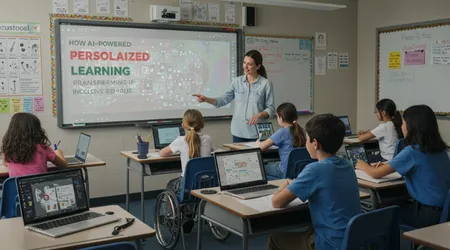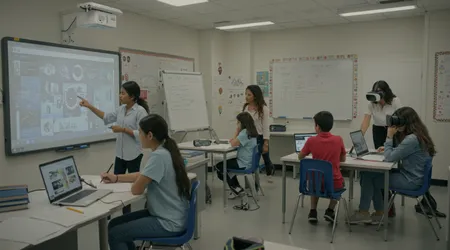How AI-Powered Personalized Learning is Transforming Inclusive Education

Personalized learning is redefining education, breaking barriers for students with diverse needs. In 2025, artificial intelligence (AI) drives this transformation, tailoring education to individual strengths.
Inclusive education, once a challenge, now thrives with AI’s ability to adapt content, pace, and methods. This article explores how AI-powered tools create equitable learning environments, ensuring no student is left behind.
From adaptive platforms to real-time feedback, the impact is profound. Why settle for one-size-fits-all when technology can customize education? Let’s dive into how AI is reshaping inclusive education with precision and empathy.
The promise of inclusive education lies in its commitment to equity. AI enhances this by analyzing student data to deliver tailored experiences.
It’s not just about access; it’s about meaningful engagement. With global education systems embracing technology, AI’s role in fostering inclusion is undeniable.
A 2023 study by the World Economic Forum noted AI-driven tutoring boosts outcomes for 98% of students compared to traditional methods.
This article will unpack AI’s applications, benefits, challenges, and future in inclusive education, offering insights for educators and families alike.
AI as a Catalyst for Inclusive Education
AI revolutionizes inclusive education by adapting to diverse learning needs. Tools like adaptive learning platforms assess student progress in real time.
They adjust content difficulty, ensuring students with disabilities engage meaningfully. For example, a dyslexic student might use an AI tool that converts text to speech.
This fosters independence, unlike traditional methods requiring constant teacher support. AI’s precision empowers students to learn at their own pace, promoting equity.
Beyond adaptation, AI supports multilingual classrooms. Real-time translation tools, like those on Duolingo, break language barriers for non-native speakers.
These tools analyze speech patterns, offering instant feedback to improve pronunciation. A student in Egypt, for instance, might use AI to access Arabic-English content tailored to their level.
++ Adapting Science Labs for Physical and Cognitive Accessibility
Such innovations ensure cultural and linguistic inclusion, making education accessible to diverse populations.
Moreover, AI reduces teacher workload, allowing focus on student interaction. Platforms like Carnegie Learning automate grading, freeing educators to address individual needs.
This shift redefines teaching roles, emphasizing mentorship over administration. By streamlining tasks, AI ensures teachers can support students with special needs, fostering a more inclusive environment. The result is a classroom where every student feels valued and empowered.

The Power of Personalized Learning in Action
Imagine a classroom where each student’s needs are met instantly. AI makes this reality through personalized learning platforms.
These systems analyze data like test scores and engagement patterns. For instance, a student with autism might receive visual aids tailored to their sensory preferences.
This customization boosts engagement, as shown in a 2023 study where AI platforms improved test scores by 62%.
Real-world examples highlight AI’s impact. In Malaysia’s School in Hospital program, AI crafts lessons for students undergoing medical treatment.
Also read: Supporting College Students with ADHD Beyond Accommodations
Adaptive platforms adjust content for emotionally vulnerable learners, ensuring continuity.
Another example is a U.S. school using AI to create individualized education plans (IEPs) for students with ADHD. These plans adapt tasks to attention spans, improving focus and outcomes.
AI also fosters collaboration. Virtual labs and gamified platforms, like those from Eduaide.AI, engage students with interactive content.
A student with motor disabilities might use voice-activated tools to participate in group projects. This inclusivity ensures no one is sidelined.
By tailoring experiences, AI transforms classrooms into dynamic spaces where diversity is a strength, not a barrier.
Overcoming Barriers with AI-Driven Solutions
Inclusive education faces challenges like resource inequity and teacher training. AI addresses these by democratizing access to quality resources.
Platforms like Magoosh provide tailored test prep for students in under-resourced areas. These tools analyze performance, offering practice questions suited to individual gaps. This levels the playing field, ensuring equitable opportunities.
Language barriers also hinder inclusion. AI-powered tools like DeepL generate bilingual content, supporting non-English speakers. In Lebanon, AI platforms deliver culturally relevant lessons, enhancing engagement.
These tools adapt to proficiency levels, ensuring accessibility. By breaking down linguistic divides, AI fosters a sense of belonging for diverse learners.
Read more: How to Make School Field Trips Accessible for All Students
Teacher readiness is another hurdle. AI offers professional development, recommending courses based on educators’ needs. For example, platforms like Remind use AI to enhance parent-teacher communication, supporting inclusive strategies.
By upskilling educators, AI ensures they can implement personalized learning effectively, creating classrooms where every student thrives.
Ethical Considerations in AI-Powered Education
AI’s potential comes with ethical responsibilities. Data privacy is a top concern, as AI relies on student information. Schools must enforce strict data protection to prevent misuse.
For instance, GDPR-compliant platforms ensure secure data handling, building trust. Without these measures, AI risks compromising student safety.
Algorithmic bias is another challenge. If trained on skewed data, AI can perpetuate inequalities. A 2021 study highlighted gender bias in language translation tools, affecting learning outcomes.
Developers must use diverse datasets to mitigate this. Educators, too, need training to recognize and address bias, ensuring fairness in personalized learning.
Equity in access remains critical. Not all students have devices or internet access, deepening the digital divide. Initiatives like Sub-Saharan Africa’s AI tutoring platforms show promise, but scalability is key.
Policymakers must prioritize infrastructure to ensure AI benefits all, not just privileged groups. Ethical AI use is non-negotiable for true inclusion.
The Future of Personalized Learning in Inclusive Education
Looking ahead, AI’s role in inclusive education will expand. Predictive analytics will identify struggling students early, enabling timely interventions.
Imagine a system flagging a student’s reading difficulties before they fall behind. Such tools, like those from Arizona State University, already show promise in boosting performance.
Integration with emerging technologies, like virtual reality, will enhance personalized learning. VR can simulate inclusive environments for students with sensory impairments.
For example, a deaf student might use VR to practice sign language with AI avatars. These innovations will make learning immersive and accessible, pushing boundaries of inclusion.
Policy will shape AI’s future. Governments must fund equitable access and ethical guidelines. The World Economic Forum’s 2023 report emphasizes AI’s potential to reduce educational disparities.
By investing in teacher training and infrastructure, policymakers can ensure personalized learning reaches every student, creating a future where education is truly inclusive.
Real-World Impact: A Closer Look
Consider Sarah, a visually impaired student in a rural school. AI-powered tools like text-to-speech software allow her to access textbooks independently.
These tools adapt content to her pace, boosting confidence. Without AI, Sarah might rely on limited human support, hindering her progress. This shows how AI empowers individual learners.
In another case, a Chicago school district uses AI to support students with learning disabilities. Platforms like Magic School AI generate customized lesson plans, aligning with IEPs.
Teachers report higher engagement and better outcomes. This practical application underscores AI’s ability to transform inclusive education through tailored solutions.
AI’s scalability is its strength. In developing nations, AI platforms deliver low-cost education to remote areas. For instance, Sub-Saharan Africa’s AI tutors adapt to local languages, ensuring relevance.
These examples highlight AI’s potential to bridge gaps, making education a universal right, not a privilege.
A Classroom Analogy: AI as a Master Tailor

Think of AI as a master tailor crafting a bespoke suit for each student. Just as a tailor measures every detail, AI analyzes learning styles, strengths, and challenges.
The result is a perfectly fitted education, unlike the off-the-rack approach of traditional systems. This analogy captures AI’s precision in delivering personalized learning, ensuring every student shines.
This tailored approach doesn’t replace teachers but enhances their craft. Like a tailor collaborating with a designer, AI supports educators in creating inclusive environments.
It provides tools to adjust lessons, monitor progress, and foster engagement. The result is a classroom where diversity is celebrated, and every student’s potential is unlocked.
The impact is tangible. A 2024 report by MDPI found AI-driven platforms increased engagement by 40% for students with disabilities.
This statistic underscores AI’s role in making education accessible. By stitching together technology and empathy, AI creates a fabric of inclusion that benefits all learners.
Challenges to Scale and Sustain AI Integration
Scaling AI in education requires infrastructure investment. Many schools lack reliable internet or devices, limiting access. Governments must prioritize funding to bridge this gap.
For example, India’s AI education initiatives face challenges due to uneven tech access, highlighting the need for equitable solutions.
Teacher adoption is another hurdle. Resistance to AI stems from unfamiliarity or fear of replacement. Professional development, like AI literacy programs, can ease this transition.
Platforms like Coursera offer courses to upskill educators, ensuring they embrace AI as a tool, not a threat.
Sustainability is critical. AI systems require updates and maintenance to remain effective. Schools must budget for long-term costs, as seen in California’s AI integration policies.
By addressing these challenges, educators can ensure AI’s benefits are widespread and enduring, transforming inclusive education.
Table: AI Tools Enhancing Inclusive Education
| Tool | Function | Impact on Inclusion |
|---|---|---|
| Duolingo AI Tutor | Real-time language translation | Supports multilingual students |
| Carnegie Learning | Automated grading and feedback | Frees teachers for student-focused tasks |
| Magic School AI | Custom lesson plans and IEPs | Tailors content for diverse needs |
| DeepL | Bilingual content generation | Breaks language barriers |
| Magoosh | Personalized test prep | Levels access for under-resourced students |
Conclusion: A New Era for Inclusive Education
AI-powered personalized learning is more than a trend it’s a revolution. By tailoring education to individual needs, AI dismantles barriers of disability, language, and access.
From real-time translations to adaptive platforms, it empowers students and educators alike. The journey isn’t without challenges privacy, bias, and equity demand vigilance.
Yet, with ethical implementation, AI can create classrooms where every student thrives. The future of inclusive education is here, driven by technology that sees every learner as unique. Will we embrace this opportunity to redefine education for all?
The path forward requires collaboration. Educators, policymakers, and developers must work together to ensure AI serves every student.
By investing in infrastructure, training, and ethical guidelines, we can build an inclusive future. AI isn’t just transforming education it’s unlocking human potential, one personalized lesson at a time.
Frequently Asked Questions
1. How does AI ensure fairness in personalized learning?
AI can reduce bias by using diverse datasets and objective algorithms, but educators must monitor for fairness to prevent perpetuating inequalities.
2. Can AI replace teachers in inclusive education?
No, AI supports teachers by automating tasks and personalizing content, allowing educators to focus on mentorship and human connection.
3. What are the risks of AI in education?
Risks include data privacy breaches, algorithmic bias, and unequal access. Strict regulations and equitable policies are essential to mitigate these.
4. How can schools afford AI tools for inclusive education?
Grants, public-private partnerships, and scalable platforms like open-source AI tools can make AI accessible to resource-constrained schools.
5. How does AI support students with disabilities?
AI provides tools like speech-to-text, adaptive content, and sensory-friendly interfaces, ensuring tailored support for diverse learning needs.
